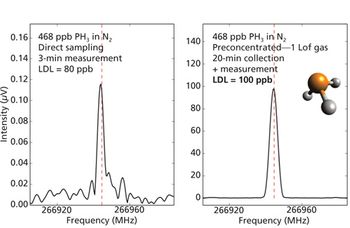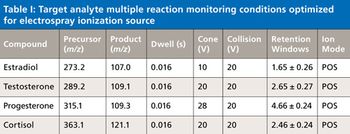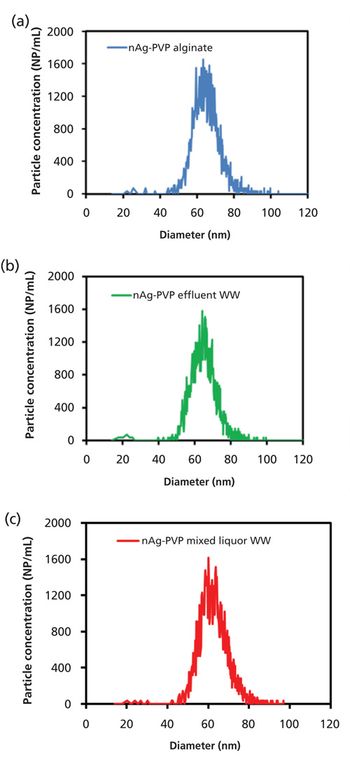
Special Issues
Gas chromatography, ICP-MS, ICP-OES, and other bulk analysis methods applied to groundwater in proximity to unconventional oil and natural gas extraction activities.

Special Issues
Gas chromatography, ICP-MS, ICP-OES, and other bulk analysis methods applied to groundwater in proximity to unconventional oil and natural gas extraction activities.

Special Issues
The connection of a quantum spectral fingerprint to molecular structure makes spectroscopy ideal for chemical detection. Even with the broad utility of chromatography and mass spectrometry, there is still a rigor to expand the applicability of high resolution spectroscopy by miniaturizing FT-NMR and enhancing the performance of mid-IR techniques. While IR instrumentation experts have been incorporating the latest diode lasers, molecular rotational resonance (MRR) spectroscopists have designed a digital, solid-state approach to reach subTerahertz (millimeter/submillimeter-wave) molecular spectroscopy from the radio regime. Recent innovations for FT-MRR techniques have finally brought millimeter-wave spectroscopy into the modern age. FT-MRR spectroscopy is applied here to gas analyses, air analysis, and headspace analysis for sensitive, chemically specific detection of VOCs without the need for lasers, chemometrics, or chromatography.

Special Issues
Sample pre-treatment is one of the bottlenecks in analytical chemistry specially when dealing with complex matrices like environmental samples. When performed in a batch mode, sample handling methods are tedious and time consuming. Therefore, the hyphenation of these methods with flow injection techniques yields many advantages. The possibility of automation not only increases the determination rate, but also decreases sample and reagent consumption. As a consequence, analyte separation, enrichment, and elimination of sample matrix becomes possible with an increase in selectivity and sensitivity. This is a significant contribution for the analysis of environmental samples as the analyte is usually present at trace levels in a complex matrix. In this scenario, the state of the art of solid phase spectrometry (SPS) with a focus on the lab-on-valve (LOV) platform is discussed. LOV facilitates the manipulation of bead suspension for SPS with lower reagents consumption and waste production.

Special Issues
This article describes a cost-effective and sensitive approach for quantifying waterborne arsenic based on gas-phase chemiluminescence. The approach centers on the use of laboratory-built instruments-one for laboratory use and one field-deployable version-that can quantify total arsenic as well as individually measure As(III) and As(V). The regulatory limit for arsenic in drinking water is 10 μg/L. The limits of detection of the gas-phase chemiluminescence instruments are well below 1 μg As/L and the linear range extends to >100 μg As/L. Total arsenic analysis using this approach requires 3 min.

Special Issues
Here we highlight some of the opportunities associated with combining advanced sample preparation techniques with state-of-the-art chemical analysis techniques. This article considers the unique combination of selective pressurized liquid extraction (SPLE) with gas chromatography coupled with mass spectrometry (MS) and ultra-performance liquid chromatography coupled with tandem MS-MS (UPLC-MS-MS). We use this powerful combination to develop a novel analytical technique capable of measuring hormones and organic contaminants in whale earwax plugs. We explore the analytical challenges with such combinations and the advantages of focusing both on sample preparation as well as instrumentation associated with chemical analysis.

Special Issues
Single particle inductively coupled plasma mass spectrometry (SP-ICP-MS) is an exciting new technique for detecting and characterizing metal nanoparticles (NP) at very low concentrations. It is fast and can provide significantly more information than other traditional techniques, including particle number concentration, particle size, and size distribution, in addition to the concentration of dissolved metals in solution. The added benefit of using ICP-MS is that it can distinguish between particles of different elemental compositions. The study will investigate the use of SP-ICP-MS to track the release of ENMs into the environment and to better understand their fate and behavior specifically in drinking, surface and wastewater samples.

Special Issues
A brief introduction to the articles presented in this supplement.

Special Issues
Click the title above to open the LCGC North America October 2015 Advancing Environmental Analysis Supplement, Vol 33 No s10, in an interactive PDF format.